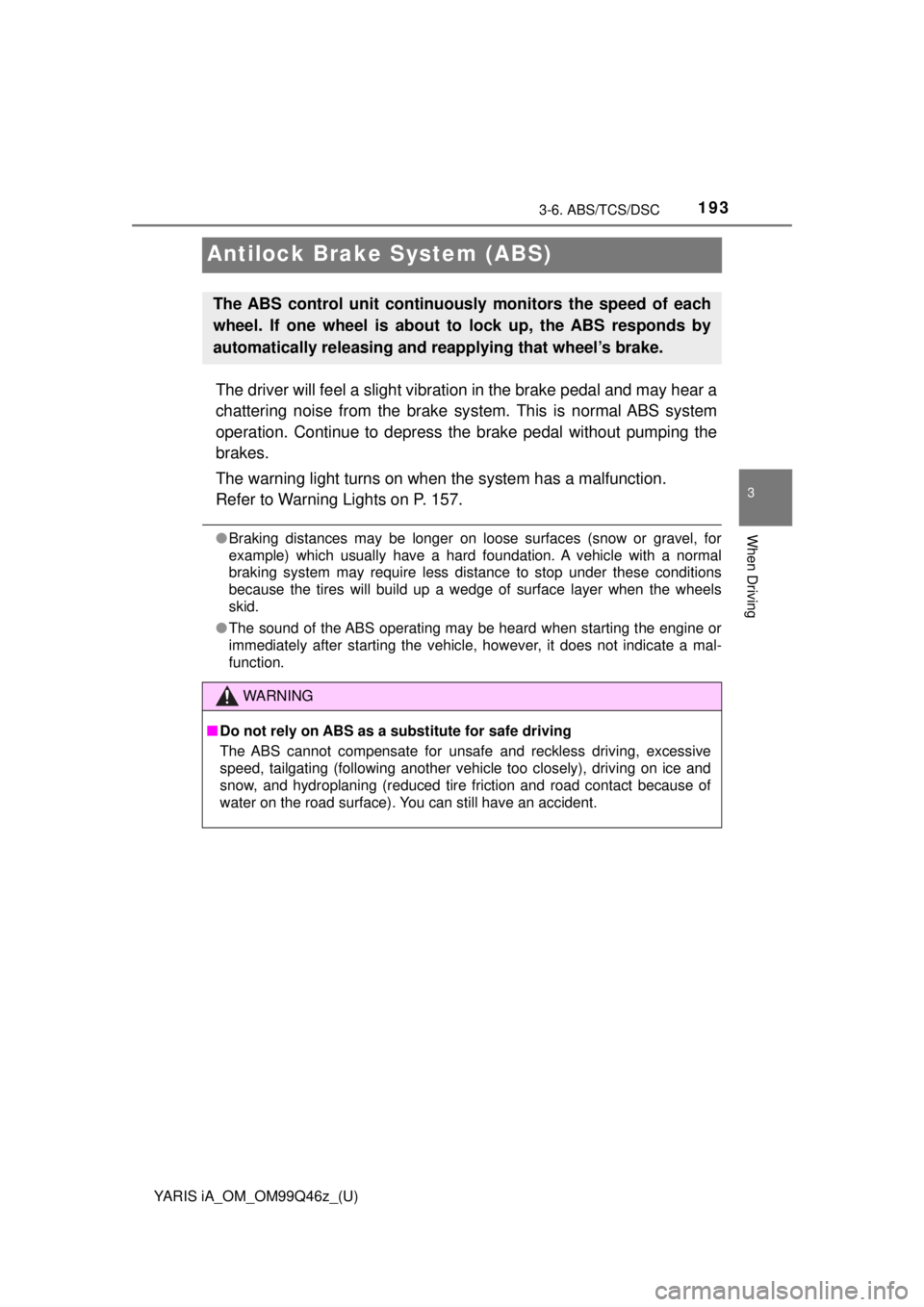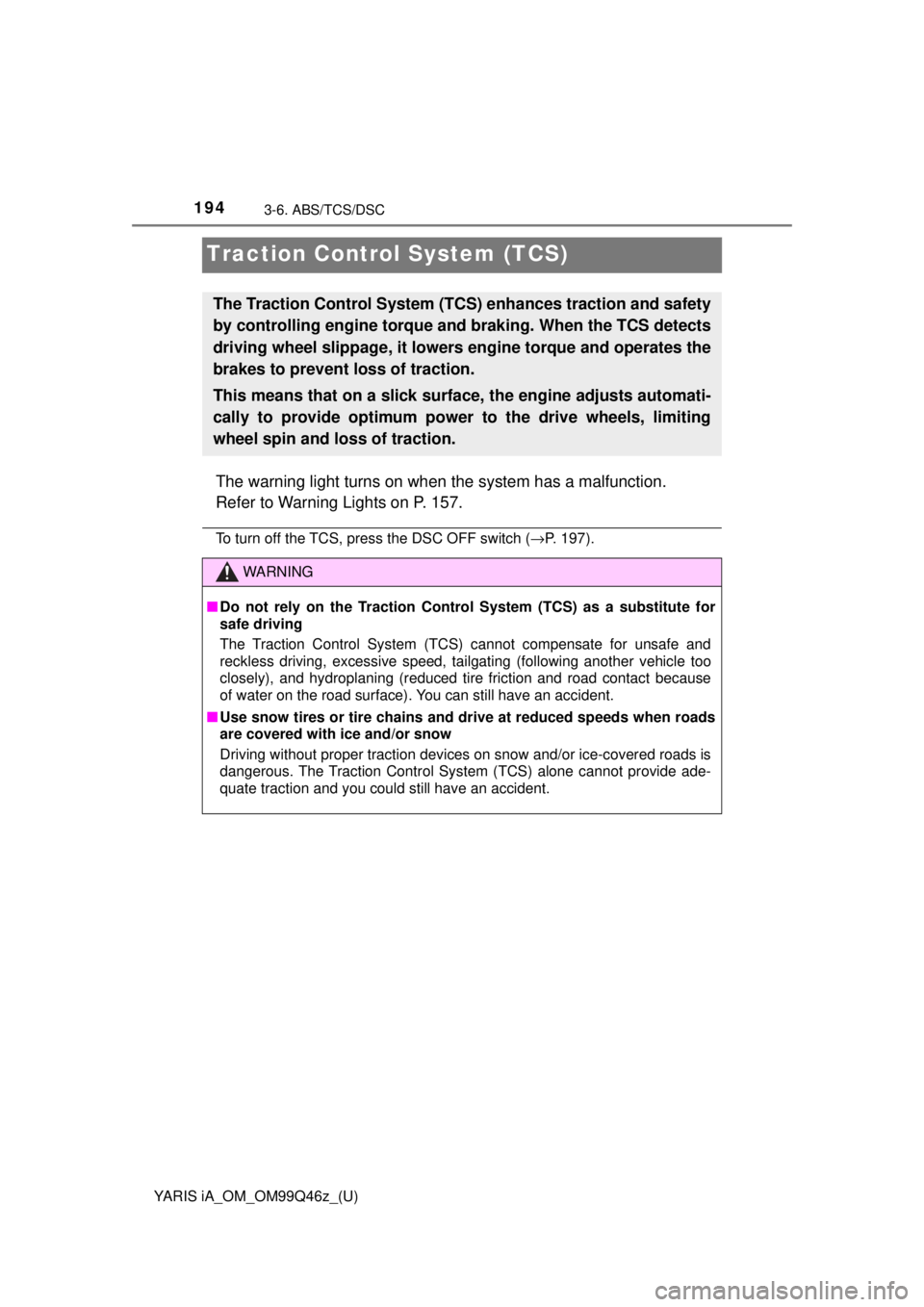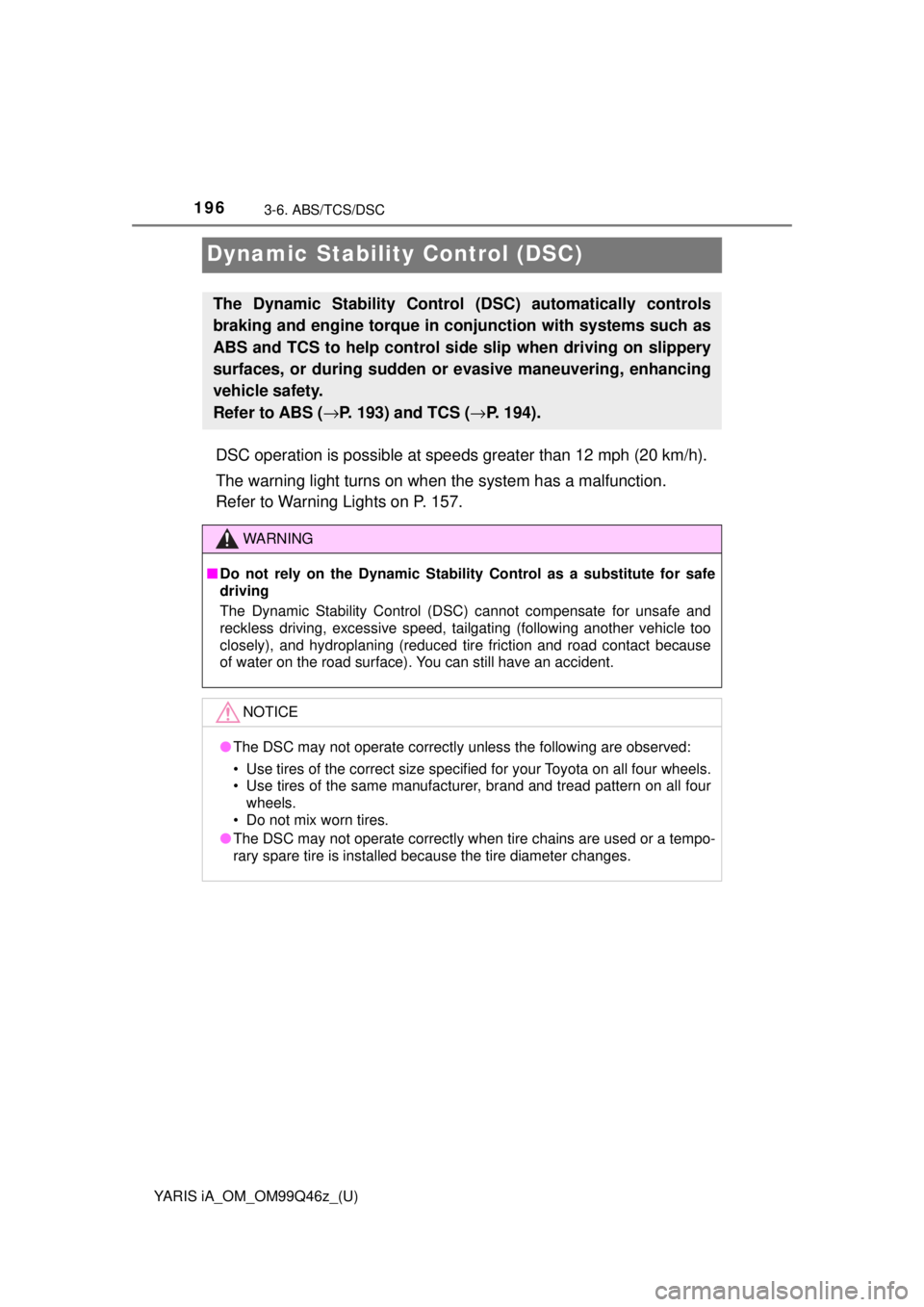Page 193 of 576

193
YARIS iA_OM_OM99Q46z_(U)
3-6. ABS/TCS/DSC
3
When Driving
Antilock Brake System (ABS)
The driver will feel a slight vibration in the brake pedal and may hear a
chattering noise from the brake system. This is normal ABS system
operation. Continue to depress the brake pedal without pumping the
brakes.
The warning light turns on when the system has a malfunction.
Refer to Warning Lights on P. 157.
● Braking distances may be longer on loose surfaces (snow or gravel, for
example) which usually have a hard foundation. A vehicle with a normal
braking system may require less distance to stop under these conditions
because the tires will build up a wedge of surface layer when the wheels\
skid.
● The sound of the ABS operating may be heard when starting the engine or
immediately after starting the vehicle, however, it does not indicate a mal-
function.
The ABS control unit continuously monitors the speed of each
wheel. If one wheel is about to lock up, the ABS responds by
automatically releasing and reapplying that wheel’s brake.
WARNING
■ Do not rely on ABS as a substitute for safe driving
The ABS cannot compensate for unsafe and reckless driving, excessive
speed, tailgating (following another vehicle too closely), driving on ic\
e and
snow, and hydroplaning (reduced tire friction and road contact because of
water on the road surface). You can still have an accident.
Page 194 of 576

194
YARIS iA_OM_OM99Q46z_(U)
3-6. ABS/TCS/DSC
Traction Control System (TCS)
The warning light turns on when the system has a malfunction.
Refer to Warning Lights on P. 157.
To turn off the TCS, press the DSC OFF switch ( →P. 197).
The Traction Control System (TCS) enhances traction and safety
by controlling engine torque a nd braking. When the TCS detects
driving wheel slippage, it lowers engine torque and operates the
brakes to prevent loss of traction.
This means that on a slick surface, the engine adjusts automati-
cally to provide optimum power to the drive wheels, limiting
wheel spin and loss of traction.
WARNING
■ Do not rely on the Traction Control System (TCS) as a substitute for
safe driving
The Traction Control System (TCS) cannot compensate for unsafe and
reckless driving, excessive speed, tailgating (following another vehicle too
closely), and hydroplaning (reduced tire friction and road contact because
of water on the road surface). You can still have an accident.
■ Use snow tires or tire chains and drive at reduced speeds when roads
are covered with ice and/or snow
Driving without proper traction devices on snow and/or ice-covered roads is
dangerous. The Traction Control System (TCS) alone cannot provide ade-
quate traction and you could still have an accident.
Page 196 of 576

196
YARIS iA_OM_OM99Q46z_(U)
3-6. ABS/TCS/DSC
Dynamic Stability Control (DSC)
DSC operation is possible at speeds greater than 12 mph (20 km/h).
The warning light turns on when the system has a malfunction.
Refer to Warning Lights on P. 157.
The Dynamic Stability Control (DSC) automatically controls
braking and engine torque in conjunction with systems such as
ABS and TCS to help control side slip when driving on slippery
surfaces, or during sudden or e vasive maneuvering, enhancing
vehicle safety.
Refer to ABS ( →P. 193) and TCS ( →P. 194).
WARNING
■Do not rely on the Dynamic Stabilit y Control as a substitute for safe
driving
The Dynamic Stability Control (DSC) cannot compensate for unsafe and
reckless driving, excessive speed, tailgating (following another vehicle too
closely), and hydroplaning (reduced tire friction and road contact because
of water on the road surface). You can still have an accident.
NOTICE
● The DSC may not operate correctly unless the following are observed:
• Use tires of the correct size specif ied for your Toyota on all four wheels.
• Use tires of the same manufacturer, brand and tread pattern on all four wheels.
• Do not mix worn tires.
● The DSC may not operate correctly when tire chains are used or a tempo-
rary spare tire is installed because the tire diameter changes.
Page 203 of 576
203
YARIS iA_OM_OM99Q46z_(U)
3-9. Power Steering
3
When Driving
Power Steering
• Power steering is only operable when the engine is running. If theengine is off or if the power steeri ng system is inoperable, you can
still steer, but it requires more physical effort.
If the steering feels stiffer than usual during normal driving or the
steering vibrates, consul t your Toyota dealer.
• The warning light notifies the dr iver of system abnormalities and
operation conditions.
In addition, the buzzer may also activate depending on the system
abnormality or operation condition.
Refer to Warning Lights on P. 157.
Refer to Power Steering Warning Buzzer on P. 516.
NOTICE
Never hold the steering wheel to the extreme left or right for more than 5
seconds with the engine running. This could damage the power steering
system.
Page 207 of 576
YARIS iA_OM_OM99Q46z_(U)
2073-10. Active Safety System
3
When Driving
●In the following cases, the laser sensor may inadvertently determine that
there is a vehicle ahead and the Smar t City Brake Support (SCBS) system
may operate.
• Objects on the road at the entrance to a curve.
• Vehicles passing in the opposite lane while making a curve.
• Metal objects, bumps, or protruding objects on the road.
• When passing through a toll gate equipped with a bar.
• When passing under a vinyl curtain or flag.
• Plastic objects such as pylons.
• Two-wheeled vehicles, pedestrians, animals or standing trees.
● Manual transaxle:
If the vehicle is stopped by the SCBS operation and the clutch pedal is not
depressed, the engine stops.
● The Smart City Brake Support (SCBS) warning light (amber) turns on when
the system has a malfunction.
Refer to Warning Lights on P. 157.
Page 218 of 576
218
YARIS iA_OM_OM99Q46z_(U)
3-12. Tire Pressure Monitoring System
Tire Pressure Monitoring System∗
The system monitors the tire pres-
sures indirectly using the data
sent from the ABS wheel speed
sensors.
To allow the system to operate correctly, the system needs to be ini-
tialized with the specified tire pressure (value on the tire pressure
label). Follow the procedure and perform the initialization.
Refer to Tire Pressure Monitoring System Initialization on P. 221.
The warning light flashes when the system has a malfunction.
Refer to Warning Lights on P. 157.
∗: If equipped
The Tire Pressure Monitoring System (TPMS) monitors the air
pressure of all four tires. If the air pressure of one or more tires
is too low, the system warns the driver by indicating the tire
pressure monitoring system warning light in the combination
meter and operating a beep sound.
ABS wheel speed sensor
Page 233 of 576

233
YARIS iA_OM_OM99Q46z_(U)
4Interior Features
4-1. Climate Control SystemOperating Tips .................. 234
Vent Operation .................. 235
Manual Type ..................... 237
4-2. Audio System Antenna ............................. 244
Operating Tips for Audio System ............................ 245
Audio Set (Type A [non-touchscreen]) .......... 258
Audio Set (Type B [touchscreen]) ................. 274
Audio Control Switch Operation ........................ 295
AUX/USB mode ................ 298 4-3. Bluetooth®
Bluetooth®......................... 319
Bluetooth® Hands-Free
(Type A) .......................... 354
Bluetooth
® Hands-Free
(Type B) .......................... 365
Bluetooth
® Audio
(Type A) .......................... 378
Bluetooth
® Audio
(Type B) .......................... 382
Troubleshooting ................ 395
4-4. Interior Equipment Sunvisors .......................... 400
Interior Lights .................... 401
Accessory Sockets............ 404
Cup Holder ........................ 405
Bottle Holder ..................... 406
Storage Compartments ..... 407
Page 401 of 576
401
YARIS iA_OM_OM99Q46z_(U)
4-4. Interior Equipment
4
Interior Features
Interior Lights
■Overhead LightsOFF
DOOR
ON
■Map Lights
When the overhead light switch
is in the door or off position,
press the lens to illuminate the
map lights, and then press the
lens again to turn them off.
1
2
3
Switch PositionOverhead Lights
OFFLight off
DOOR
• Light is on when any door is open
• Light is on or off when the illuminated entry sys-tem is on
ONLight on